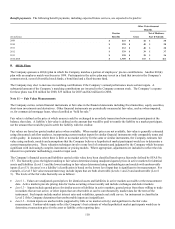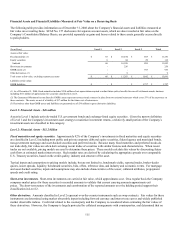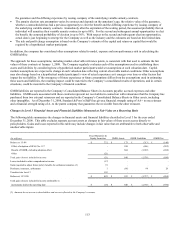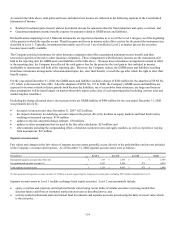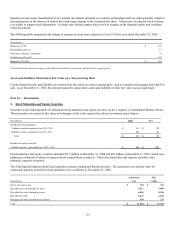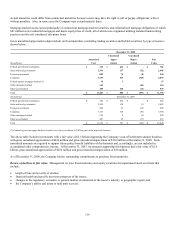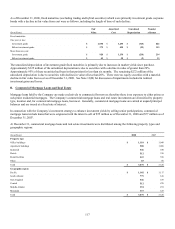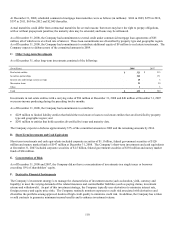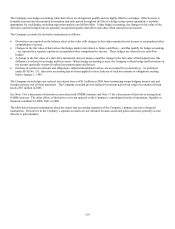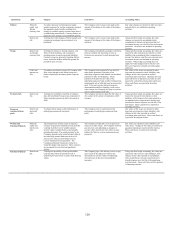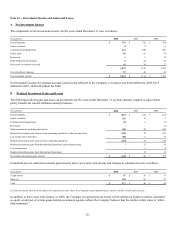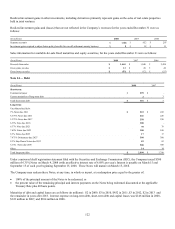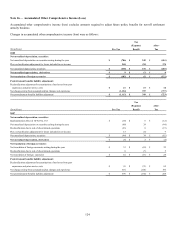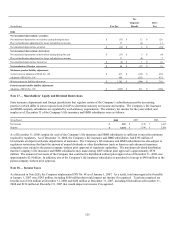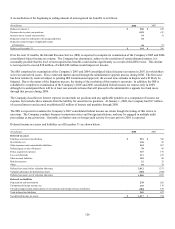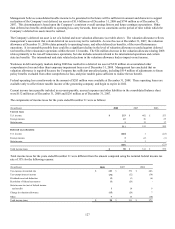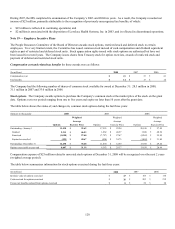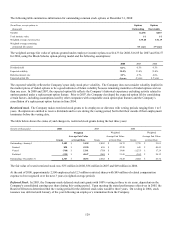Cigna 2008 Annual Report Download - page 140
Download and view the complete annual report
Please find page 140 of the 2008 Cigna annual report below. You can navigate through the pages in the report by either clicking on the pages listed below, or by using the keyword search tool below to find specific information within the annual report.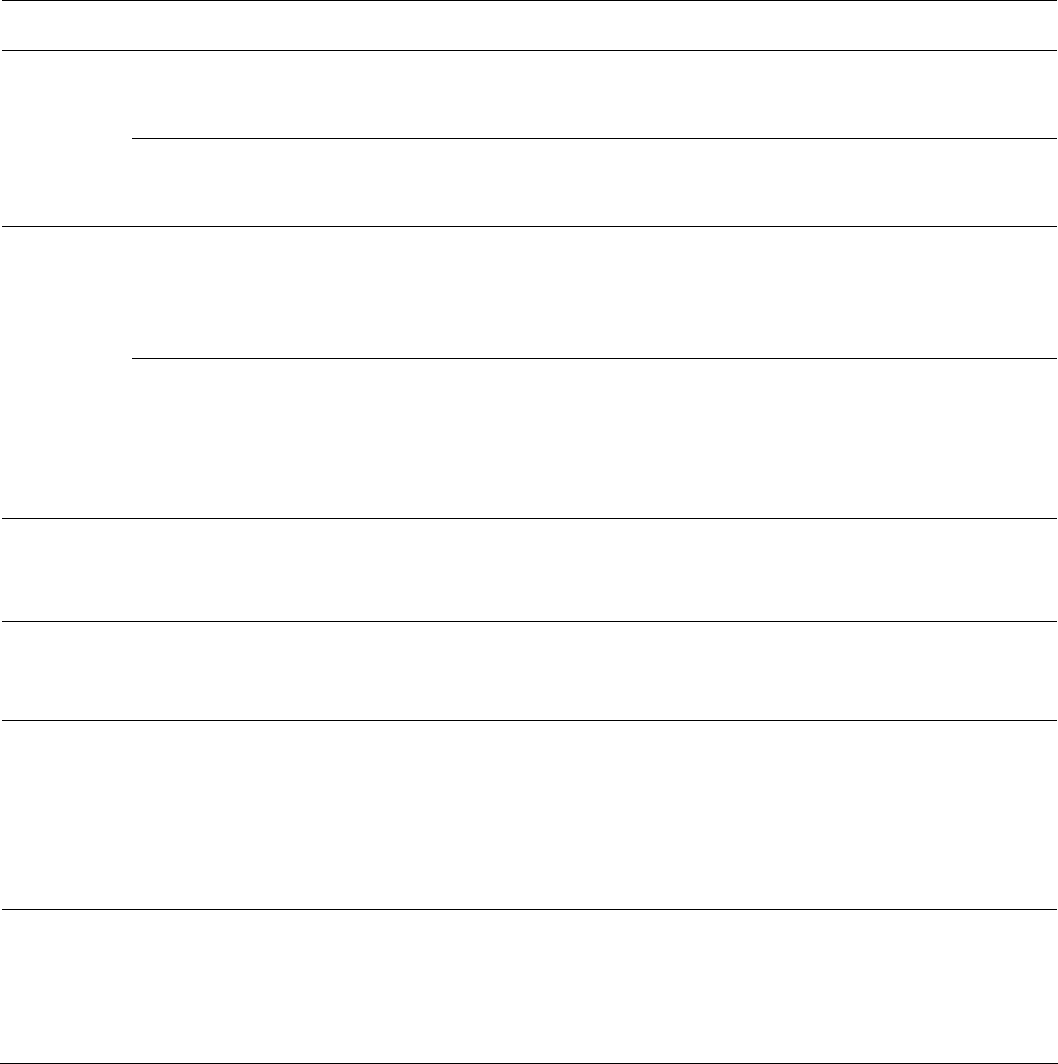
120
Instrument
Risk
Purpose
Cash Flows
Accounting Policy
Futures Primarily
equity and
foreign
currency risks
To reduce domestic and international equity
market exposures for certain reinsurance contracts
that guarantee death benefits resulting from
changes in variable annuity account values based
on underlying mutual funds. Currency futures are
primarily euros, Japanese yen and British pounds.
The Company receives (pays) cash daily in the
amount of the change in fair value of the futures
contracts.
Fair value changes are reported in other revenues
and cash flows are included in operating
activities.
Interest rate
risk
To hedge fair value changes of fixed maturity and
commercial mortgage loan investments to be
purchased.
The Company receives (pays) cash daily in the
amount of the change in fair value of the futures
contracts.
Using cash flow hedge accounting, fair value
changes are reported in accumulated other
comprehensive income and amortized into net
investment income over the life of the investments
purchased. Cash flows are included in operating
activities.
Swaps Interest rate
and foreign
currency risks
To hedge the interest or foreign currency cash
flows of fixed maturities and commercial
mortgage loans to match associated liabilities.
Currency swaps are primarily Canadian dollars,
euros, Australian dollars and British pounds for
periods of up to 13 years.
The Company periodically exchanges cash flows
between variable and fixed interest rates or
between two currencies for both principal and
interest.
Using cash flow hedge accounting, fair values are
reported in other long-term investments or other
liabilities and accumulated other comprehensive
income. Net interest cash flows are reported in net
investment income and included in operating
activities. When hedge accounting does not
apply, fair value changes and net interest cash
flows are reported in realized investment gains
and losses.
Credit and
interest rate
risks
To enhance investment returns, the Company sells
Dow Jones indexed credit default swaps on a
basket of primarily investment grade corporate
bonds.
The Company receives quarterly fees and will
make future payments if an issuer of an
underlying corporate bond defaults on scheduled
payments or files for bankruptcy. These
payments will equal the par value of the
underlying corporate bond and the Company may
subsequently sell or hold that bond as an invested
asset. If the most current indexed swaps are
determined desirable for liquidity, credit risk or
other reasons, the Company also pays or receives
cash to settle purchases and sales.
Fair values of the swaps are reported in other
long-term investments or other liabilities, with
changes in fair value reported in realized
investment gains and losses. Quarterly fees and
gains and losses on purchases and sales are also
reported in realized investment gains and losses.
These cash flows are reported in investing
activities.
Treasury lock Interest rate
risk
To hedge the variability of and fix at inception
date, the benchmark Treasury rate component of
future interest payments on debt to be issued in
2009.
The Company will receive (pay) the fair value of
the contract at the earliest of expiration or debt
issuance.
Using cash flow hedge accounting, fair values are
reported in short-term investments or other
liabilities, with changes in fair value reported in
accumulated other comprehensive income and
amortized to interest expense over the life of the
debt issued. These cash flows are reported in
operating activities.
Swaps on
commercial loan
pools
Interest rate
and credit
risks
To obtain returns based on the performance of
underlying commercial loan pools.
The Company receives cash based on the
performance of underlying commercial loan
pools.
Fair values of the swaps are reported in other
long-term investments or other liabilities, with
changes in fair value reported in realized
investment gains and losses. These cash flows are
reported in investing activities.
Written and
Purchased Options
Primarily
equity and
interest rate
risks
The Company has written certain reinsurance
contracts to guarantee minimum income benefits
resulting from the level of variable annuity
account values compared with a contractually
guaranteed amount. The actual payment by the
Company depends on the actual account value in
the underlying mutual funds and the level of
interest rates when account holders elect to
receive minimum income payments. The
Company purchased reinsurance contracts to
hedge the market risks assumed. These contracts
are accounted for as written and purchased
options.
The Company periodically receives (pays) fees
based on account values. The Company will also
pay (receive) cash depending on changes in
account values and interest rates when account
holders first elect to receive minimum income
payments.
Fair values are reported in other liabilities and
other assets. Changes in fair value are reported in
guaranteed minimum income benefits expense.
These cash flows are reported in operating
activities.
Purchased Options Interest rate
risk
To hedge the possibility of early policyholder
cash surrender when the amortized cost of
underlying invested assets is greater than their fair
values.
The Company pays a fee and may receive or pay
cash, based on the difference between the
amortized cost and fair values of underlying
invested assets at the time of policyholder
surrender.
Using cash flow hedge accounting, fair values are
reported in other assets or other liabilities, with
changes in fair value reported in accumulated
other comprehensive income and amortized to
benefits expense over the life of the underlying
invested assets. These cash flows will be reported
in financing activities.


